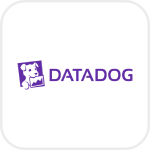
- Overview
- Configuration
Datadog
Automate user management with Datadog and ADManager Plus integration
Datadog is a cloud-based monitoring and analytics platform that enables organizations to improve agility, increase efficiency, and provide end-to-end visibility across high-scale applications and infrastructure. By integrating Datadog to AD using ADManager Plus IT teams can improve their operational capabilities by facilitating real-time security monitoring and automated management of user identities and access. This integration lets teams increase collaboration by facilitating synchronization of user data between AD and other integrated business applications, guaranteeing that user accounts consistently reflect the most current employee information.
Automated user onboarding
Streamline the process of creating and configuring new user accounts in AD as soon as they are added to Datadog, ensuring immediate access to necessary systems and tools.
Automate user updates
Keep user roles and permissions in sync across both platforms. As roles or responsibilities change within Datadog, corresponding updates are automatically reflected in AD, maintaining alignment with current job functions and security policies.
Automate user offboarding
Automatically deactivate or delete user accounts from AD when they are removed from Datadog, enhancing security by ensuring that only current employees have access to sensitive systems and data.
Need assistance to integrate Datadog with ADManager Plus?
How to integrate ADManager Plus and Datadog
Prerequisites:
Please ensure to provide an API key with permissions to retrieve desired information and perform tasks in Datadaog. Refer to Datadaog's API references for more details.
Privileges:
- To import users from Datadog (Inbound action): Ensure the account used for authorization has permission to read all user accounts.
- To perform any action or query in Datadog (Outbound Action): Ensure the account used for authorization has permission to perform the desired action.
Authorization configuration
- Log in to ADManager Plus and navigate to the Automation tab.
- In the left pane, under Configuration, click Application Integrations.
- Under Enterprise Applications, click Datadog.
- Toggle the Enable Datadog Integration button on.
- In the Datadog Configuration page, click Authorization.
- Perform the steps to generate the API Keys and API Token in Datadog and enter the API Key in the value field.
- Click Configure.
Inbound webhook configuration
Inbound webhook enables you to fetch user data from Datadog to ADManager Plus. The attribute mapping configured in this section can be selected as the data source during automation configuration.
To configure an inbound webhook for Datadog:
- Under Inbound Webhook, click Datadog Endpoint Configuration.
- In the Endpoint Configuration tab, an endpoint, Datadog USERS ENDPOINT, comes pre-configured with an Endpoint URL, API Method, Headers, and Parameters fields to fetch user accounts from Datadog. If you would like to use this pre-configured endpoint, replace {id} with the domain name of your Datadog instance in the Endpoint URL field. However, if you would like to use a new endpoint to import users, you can configure one using the + Add API endpoint button and filling in the required fields as per Datadog's API references. Click here to learn how.
- The API key value pair is preconfigured as a header for authenticating API requests as configured during Authorization Configuration.
- Macros: Explain about macros how they can use these to dynamically change the endpoint to meet their requirement.
- Refer to Datadog's API references and configure additional headers and parameters, if required.
- Once done, click Test & Save. A response window will display all the requested parameters that can be fetched using the API call. Click Proceed.
- Refer to Datadog's API references to know the Parameters that must be configured to fetch only specific parameters.
- You can configure multiple endpoints for Datadog using the + Add API endpoint button. Click here to learn how.
- Click Data Source - LDAP Attribute Mapping to match endpoints and to map AD LDAP attributes with the respective attributes in Datadog. [ADManager Plus also lets you customize attribute format from Datadog]
- Click + Add New Configuration and perform the following:
- Enter the Configuration Name and Description and select the Automation Category from the drop-down menu.
- In the Select Endpoint field, select the desired endpoint and a Primary Key that is unique to a user (e.g. employeeIdentifier). Note: When multiple endpoints are configured, this attribute must hold the same value in all the endpoints.
- In the Attribute Mapping field, select the attribute from the LDAP Attribute Name drop-down menu and map it with the respective column in Datadog.
- If you would like to create a new custom format for this, click Mapping Attribute.
- Click Save.
Note:
Note:
Outbound webhook configuration
Outbound webhook enables you to update the changes made in AD using ADManager Plus to Datadog or fetch/forward required details from Datadog and synchronize them with AD.
To configure an outbound webhook for Datadog:
- Under Outbound Webhook, click Datadog Webhook Configuration.
- Click + Add Webhook.
- Enter a name and description for this webhook.
- Decide on the action that has to be performed and refer to Datadog's API references for the API details, such as the URL, headers, parameters, and other requirements that will be needed.
- Select the HTTP method that will enable you to perform the desired action on the endpoint from the drop-down menu.
- Enter the endpoint URL.
- Configure the Headers, Parameters, and Message Type in the appropriate format based on the API call that you would like to perform.
- Click Test and Save.
- A pop-up window will then display a list of AD users and groups to test the configured API call. Select the desired user or group over which this API request has to be tested and click OK. This will make a real-time call to the endpoint URL, and the selected objects will be modified as per the configuration.
- The webhook response and request details will then be displayed. Verify them for the expected API behavior and click Save.

